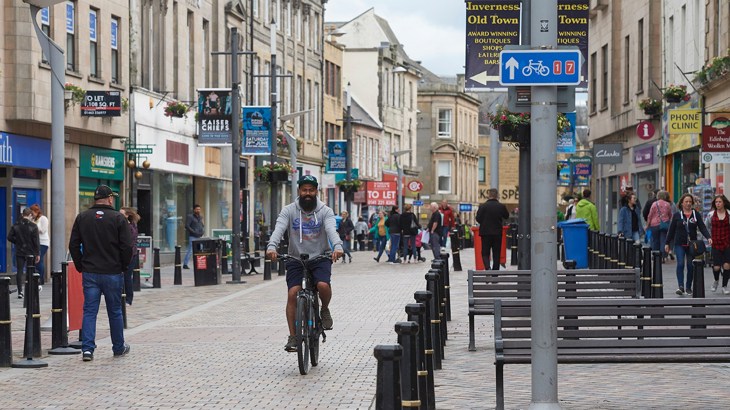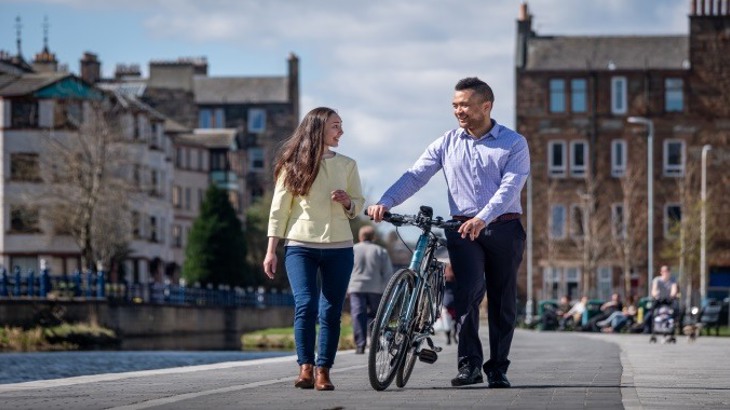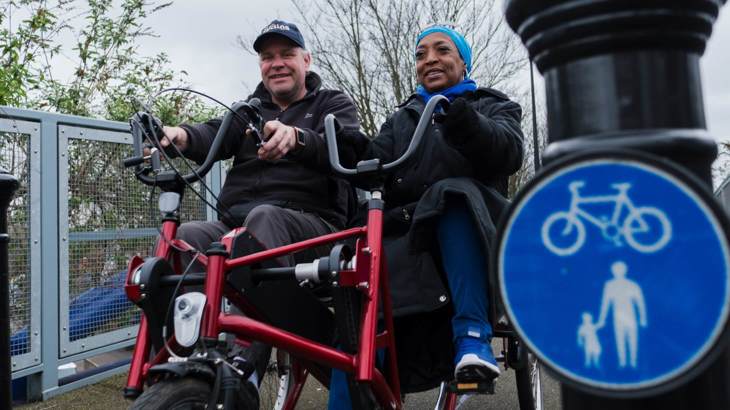Sustrans Scotland welcomes the opportunity to provide evidence to the Just Transition Commission. We strongly support moves to create an equitable, low-carbon economy, in which walking, cycling and wheeling should play a central role.

1. What do you see as the main economic opportunities and challenges associated with meeting Scotland’s climate change targets?
Covid-19 – Resetting the economy and building back better
The ongoing pandemic provides challenges to the transport transition, particularly in its negative impact on public transport.
Car usage is rebounding rapidly and may soon exceed pre-pandemic levels – bringing negative impacts such as congestion, air pollution, and higher carbon emissions.
However, the growth in walking and cycling during lockdown, plus the growing interest in localism, provides an opportunity to bring about long-term positive changes in behaviour, supported by temporary infrastructure schemes to enable physical distancing.
Higher levels of home working could also reduce transport demand in the long term, whilst providing new opportunities for local economies.
Evidence suggests that many higher earners are seeking to relocate out of major cities in the wake of the pandemic – providing opportunities for localism and the regeneration of town centres outside the major cities, whilst also bringing risks to city economies, and of further embedding inequalities.
Cycling helps to beat congestion and can unlock growth. The London Cycle Superhighway corridors move 2-3 times more people than general traffic lanes (Transport for London, 2015). In Edinburgh, congestion is estimated to have cost £225 million in 2016.
People walking and cycling deliver local economic benefits to retail vitality. People travelling by bike or on foot spend more money overall than motorists, and high street walking and cycling projects have been shown to increase retail sales by 30% or more.
Walking and cycling also draw in money through tourism, especially to small business and rural economies. Walking tourism is worth £1.26 billion to the Scottish economy.
Rethinking our high streets
Shopping patterns have changed. A 2019 report predicted that half of all retail sales would be online with 10 years. This trend has been accelerated by the pandemic.
Retail will always be important, but town centres can be repurposed as community hubs – places to gather, work, and access services. Active travel and placemaking in our town centres will support local regeneration, and well-planned town centre living can support intergenerational living.
Greater support for shared transport models – where car clubs and bike hire complement public transport – could be transformative, providing an attractive and equitable alternative to car ownership. This would contribute to the Scottish Government’s circular economy aims, reducing resource consumption and emissions, whilst providing service-based jobs in maintenance and making better use of our streets.
Employment and training
Investment in active travel will stimulate employment.
Sustrans Scotland research shows that 12.7 jobs are created per £1 million invested in sustainable transport, compared with 2.2 per £1 million for the M8 improvements and 0.9 for the Queensferry Crossing.
This is backed up by analysis from the STUC, which shows that swift investment in active travel infrastructure could create 18,000 jobs in Scotland over two years, with a wider investment in sustainable transport bringing that total to nearly 40,000.
Additionally, active travel helps people to access employment opportunities. Low-cost investments in access to bikes and training for jobseekers make it easier to attend training, interviews, and Jobcentre appointments (Sustrans, 2012).

Active commuting has been found to reduce the risk of cardiovascular disease, cancer and mortality by over 40%.
2. What do you think are the wider social (health, community, etc.) opportunities and challenges associated with meeting Scotland’s climate change targets?
A transition towards green and just transport and planning policy must seek to:
- Deliver net-zero emissions, and improve air quality and the natural environment
- Prioritise the most vulnerable and reduce social and health inequalities
- Improve economic resilience and wellbeing for all people.
These aims underpin the UN’s Sustainable Development Goals, with which the Scottish Government’s National Performance Framework outcomes are aligned.
Health
Active commuting has been found to reduce the risk of cardiovascular disease, cancer and mortality by over 40%.
The reduction in health risk and in the impact of health conditions associated with inactivity can, in turn, result in healthcare savings.
British Cycling estimates if Danish levels of cycling were achieved in the UK, the NHS could save around £17 billion over 20 years.
Walking and cycling also reduce absenteeism, making people happier, increasing productivity, and saving businesses money.
The levels of motorised traffic in our cities have also created an air quality crisis, impacting our health and our environment.
Reducing levels of polluting vehicles and greater support for active travel have been identified as key interventions by the Scottish Parliament’s Environment, Climate Change and Land Reform Committee.
Inequality
Car-centric design has a wide range of discriminatory impacts, impacting the most vulnerable parts of our society.
To give one example, children in the 20% most deprived areas in Scotland three times as likely to be in a collision with a car as children in the least deprived 20% of areas.
Access to green space has been a key inequality issue highlighted by the pandemic. Delivering more public green spaces and green active travel infrastructure will deliver a wide range of social benefits to those who need them most.
The transport transition must also reflect the diverse needs of rural and urban areas. Rural areas require frequent and affordable public transport to ensure fair access to services for those who don’t own cars[31], particularly over longer distances where active travel is less viable.
Technological change
Electric powered e-bikes and e-cargo bikes have already been transformative for journeys that are longer, over hillier terrain, and/or require the carrying heavier loads.
They also open up access to cycling to less fit and older people, while still providing direct and indirect health benefits.
There is significant scope to expand the use of e-cargo bikes to reduce LGV volumes in our urban areas.
Electric vehicles will form part of a balanced, sustainable transport system that meets our climate change targets, but should not be given the disproportionate prominence and support currently received by fossil-fuelled cars.
Modelling suggests we need to reduce private vehicle use between 20 and 60% by 2030 if we are to meet governmental climate change targets.
Meanwhile, electric vehicles still support single occupancy car journeys – an inefficient use of road space and energy – and the lowest income households are far less likely to own an electric vehicle than the highest-income households.

We need rapid measures to prevent a recovery from Covid-19 that is dominated by a rise in-car use. Temporary road space reallocation for active travel to enable physical distancing is crucial for this.
3. What would a successful transition to net-zero emissions look like for your sector/community?
A successful transition will require urgent measures to facilitate short, medium, and long-term changes to our transport and spatial planning systems.
In the short term, the transport transition should include rapid measures to prevent a recovery from Covid-19 that is dominated by a rise in-car use.
This will require temporary road space reallocation for active travel and enable physical distancing – particularly for retail (queueing) and hospitality (outdoor seating for cafes, restaurants and pubs).
There must also be continued support for the public transport sector, which is suffering from a drop in fare revenues driven by public caution and physical distancing measures.
In the medium term, we should develop dedicated, permanent active travel infrastructure on all key radial and orbital routes in our towns and cities, to enable the majority of short trips to be undertaken by active travel and public transport.
This will also require investment in public transport to improve regularity & accessibility – both in urban and rural areas.
Simple measures should be introduced to create low traffic neighbourhoods in all urban residential areas, reducing volumes and speeds of motorised traffic.
In the long term, we would recommend that our planning system be built around the principle of 20-minute neighbourhoods.
This will require a concerted long-term effort to invest in community-based public service provision, with accompanying measures to support high streets and neighbourhood retailers.
Alongside this, green active travel infrastructure, further improvements to public transport, and shared mobility options (such as bike hire and car sharing clubs) should provide an attractive alternative to car ownership, ensuring that sustainable and shared transport options become the default.
This should be underpinned by changes to planning guidelines, with close collaboration between the Scottish Government and local authorities.
4. What actions do you think the Scottish Government should take to manage the opportunities and challenges referenced above?
The Scottish Government should:
Put sustainability at the heart of transport investment
- Review existing funding commitments to major road-building projects, and consider reallocating these funds to active travel and sustainable transport infrastructure projects – which will be more impactful in supporting jobs and the economy, as well as supporting the wide range of social and environmental benefits highlighted earlier in our response.
- Provide increased, multi-year funding for active travel infrastructure and behaviour change projects, to enable ambitious and long-term projects
- Improve public transport operating models and increase investment in public transport
- Invest in public transport transition, particularly in low emissions buses – which could also provide additional capacity in the short term while physical distancing is required on the public transport network
- Ensure that investment works towards an integrated transport system, that makes it convenient to switch between travel modes as part of a single trip – particularly focusing on interchanges.
Create a stimulus package for living locally designed around 20-minute neighbourhoods
- Create low traffic neighbourhoods in all residential areas, reducing traffic volumes and speeds to create a safer and more welcoming environment for active travel.
- Ensure all towns and cities have dedicated active travel infrastructure on all key radial and orbital routes.
- Work with local authorities to embed a 20-minute neighbourhood approach into the planning system, which will strengthen local economies and reduce the need for long-distance travel, making active travel a realistic option for a greater proportion of journeys.
- Align investment and planning guidance around 20-minute neighbourhood principles for all new developments and give powers to local authorities to prevent development that would create greater car dependency.
- Invest in local service provision, to ensure we have a decentralised and resilient economy where people have easy access to the services they need.
- Continue to invest in local high streets to create welcoming and safe environments with more space for people to work, shop, eat, play, and access services.
Get fiscal incentives right to encourage public transport, walking and cycling
- Reduce the cost of public transport and introduce minimum service levels to reduce transport poverty, especially in semi-urban and rural areas.
- Provide further funding for access to bikes projects – including bike hire schemes and grants for low-income groups and young people.
- Incentivise the introduction of demand management measures such as road pricing, road space reallocation and workplace parking levies to encourage modal shift. When measures to manage demand are introduced, it is important that alternative modes of transport are both viable and offer a real alternative for users.
- Support the introduction of a new frequent flyer levy, with proceeds used to make surface public transport faster, greener and more affordable.

Many older people and disabled people are reliant on cars to access essential services. It should be made clear in infrastructure design and all engagement with representative groups that their needs must be accounted for.
5. Are there specific groups or communities that may be, or feel that they may be, adversely affected by a transition to a net-zero carbon economy? What steps can be taken to address their concerns?
EVs and social inequalities
An electric vehicle-centred transition could have an adverse effect on economically disadvantaged communities, further embedding existing inequalities.
Lower-income groups are less likely to own a car, with female heads of house, children, young and older people, people of BAME background and disabled people most affected.
People living in areas of the highest disadvantage are also more likely to be negatively impacted by air pollution and road safety.
This underlines the need for the transition to delivering a balanced transport system, in which active travel and public transport should be prioritised.
Disabled people and car reliant groups
Many older people and disabled people are reliant on cars to access essential services.
Vulnerable pavement users, such as those living with mobility or sensory impairments, may have concerns about moves to encourage higher levels of active travel, especially if these measures are designed to reduce car use.
It should be made clear in infrastructure design and all engagement with representative groups that their needs must be accounted for.
It is important to also emphasise the benefits of higher levels of active travel and public transport use – including more road space for those who most need it, more space for dedicated blue badge parking, and more, better-designed pavement space and public transport.
Retail sector
Organisations representing small businesses and retailers regularly cite parking availability as being key to decisions as to where people shop, which can lead to them seeing active travel infrastructure projects as a threat.
As discussed above, high streets face a wide range of challenges as the economy changes, and significant changes are inevitable – which will make this a worrying time, and makes a comprehensive, evidence-based strategy essential.
The evidence shows that active travel and placemaking investments can improve footfall, and this must be clearly communicated as part of extensive, inclusive consultations.
Measures such as click and collect and last-mile delivery by e-cargo bike can support retailers, even as the nature of the high street changes.
Rural Communities
Rural areas are in many cases strongly dependent on tourism, with 15% of employment in Argyll & Bute coming from the industry.
Rural communities may be concerned that the transition will be urban-centric and that they will suffer disproportionately from measures such as a frequent flyer levy.
It is crucial that the transition reflects that rural areas have different transport and economic needs to our towns and cities.
This should include a clear strategy to deliver economic growth and investment outside urban areas, including decentralised service provision, and significant improvements to the frequency and affordability of public transport – particularly buses.
We should also seek to ensure that active travel contributes to the rural tourist economy, with investment in the National Cycle Network and iconic long-distance routes that bring regular visitors and income.





